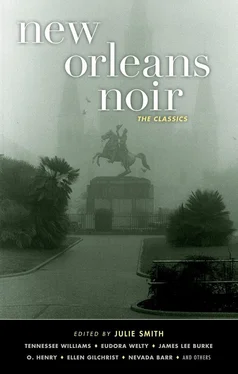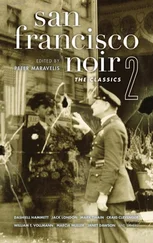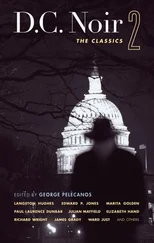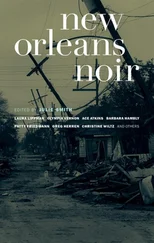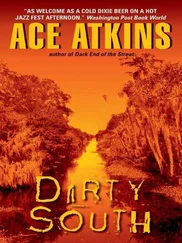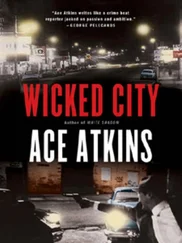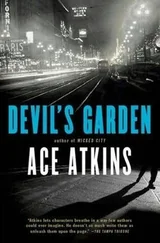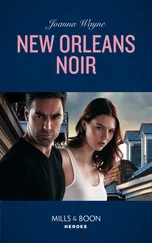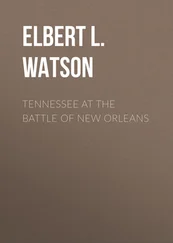Ace Atkins - New Orleans Noir - The Classics
Здесь есть возможность читать онлайн «Ace Atkins - New Orleans Noir - The Classics» весь текст электронной книги совершенно бесплатно (целиком полную версию без сокращений). В некоторых случаях можно слушать аудио, скачать через торрент в формате fb2 и присутствует краткое содержание. Город: New York, Год выпуска: 2016, ISBN: 2016, Издательство: Akashic Books, Жанр: Детектив, на английском языке. Описание произведения, (предисловие) а так же отзывы посетителей доступны на портале библиотеки ЛибКат.
- Название:New Orleans Noir: The Classics
- Автор:
- Издательство:Akashic Books
- Жанр:
- Год:2016
- Город:New York
- ISBN:978-1-61775-384-8
- Рейтинг книги:3 / 5. Голосов: 1
-
Избранное:Добавить в избранное
- Отзывы:
-
Ваша оценка:
- 60
- 1
- 2
- 3
- 4
- 5
New Orleans Noir: The Classics: краткое содержание, описание и аннотация
Предлагаем к чтению аннотацию, описание, краткое содержание или предисловие (зависит от того, что написал сам автор книги «New Orleans Noir: The Classics»). Если вы не нашли необходимую информацию о книге — напишите в комментариях, мы постараемся отыскать её.
takes a literary tour through some of the darkest writing in New Orleans history.
New Orleans Noir: The Classics — читать онлайн бесплатно полную книгу (весь текст) целиком
Ниже представлен текст книги, разбитый по страницам. Система сохранения места последней прочитанной страницы, позволяет с удобством читать онлайн бесплатно книгу «New Orleans Noir: The Classics», без необходимости каждый раз заново искать на чём Вы остановились. Поставьте закладку, и сможете в любой момент перейти на страницу, на которой закончили чтение.
Интервал:
Закладка:
New Orleans Noir: The Classics

Introduction
The Many Ways It Can All Go Away
Just after Hurricane Katrina, when New Orleans was at its most noir moment (and so were we all), I was invited by Akashic Books to put together a volume of original stories for the first New Orleans Noir . It perfectly suited all our moods down here, which might account for the extremely high quality of the stories the authors produced. The collection has remained so popular that, almost ten years later, we’re coming back for The Classics , reprinted stories by some of the finest writers who ever walked the rough-and-tumble streets of the City that Care Forgot — a pretty funny sobriquet when you consider what they wrote.
Listen to a character herein: “He had it made. Then it all went away... it always goes away. If you know anything, you know that.” So wrote John William Corrington in “Pleadings,” one of the stories collected herein. It’s one of my favorite quotes about the noir tradition. Maybe it doesn’t apply to everyone in a noir tale, or even always to the protagonist, but you can bet it perfectly describes someone’s fate.
With one exception, each of these stories reflects that scenario in some way or other — in every case there’s a terrible loss, sometimes an unbearable loss. Much like in our lives. Most of us, I hope, will deal with our losses in less murderous, self-destructive, and downright horrific ways, but stories like this, even as they make us wince, let us identify with others who’ve been there.
Sometimes you can practically feel the author’s own losses, his or her own desires for revenge or oblivion. And what a magnificent array of authors to choose from! It was a thrill to stroll through two centuries of stories written in a city as rich as delta dirt in literary tradition.
A glittering constellation of writers has passed through New Orleans — including Mark Twain, Sherwood Anderson, O. Henry, and even Walt Whitman, to name some of the not-so-usual suspects. Then there are the ones whose sojourns here are better known, the ones on whom we pride ourselves, such as Tennessee Williams, William Faulkner, Eudora Welty, Ellen Gilchrist, and James Lee Burke.
It was an anthologist’s feast — just about everybody who came to New Orleans wrote about it. But there were surprises as well.
Here’s what became apparent almost immediately: our well-known fascination with death and funerals and cemeteries and the dark side in general, coupled with our unfortunate notoriety for being Murder Central, hasn’t produced a lot of crime stories. So in many cases I’ve had to content myself with the dark and brooding. You don’t mind, do you? It’s very dark and brooding.
But considering the detective story as we know it now wasn’t even invented till 1841, nineteenth-century writers in New Orleans probably transferred more than their share of dark thoughts to paper. I noticed right away that many of our early authors were concerned with race and injustice. That’s no surprise, since race is always on our minds here and most of our neighborhoods are either mixed or cheek-by-jowl. Creole, that early word for mixed Spanish or French heritage, now means almost exclusively African American and white.
Many of our nineteenth-century writers were concerned specifically with injustice against people of color, yet most of them, at first glance, were white. My guess is this doesn’t mean black people weren’t writing, just that they didn’t find easy avenues to publication. One who did was Armand Lanusse, a well-off and well-educated free man of color who published the first collection of poetry by African Americans in the United States. He was a member of a literary group of men of similar background called Les Cenelles, which was also the name of the collection.
The story of his I’ve included is about plaçage, possibly nineteenth-century Louisiana’s most fascinating social custom. It was a contract much like marriage, but always between a white man and a Creole woman. Here’s how it was different from conventional marriage: the man was usually also married to someone else! (Invariably someone white.) Though it no doubt had advantages for some women — the men were often required to buy them houses and educate their children — Lanusse took a dim view. You could even say a noir view.
Grace King, far from being an advocate for African Americans, started writing to rebut the work of George Washington Cable, whose sympathy toward black people she considered objectionable. Given that, it’s hard to know how to interpret “The Little Convent Girl.” But I’d forgotten her opinions when I read the story, which moved me in a way that may have been different from the way King intended. Rather than try to deconstruct it, I’m going to take the view that there’s more than one truth in a strong tale.
Kate Chopin was a writer famed for her early feminist novel The Awakening , from which the first section of this anthology takes its name. In “The Story of an Hour” she writes again about the female role of the time. This one, like many of Chopin’s stories, is set on a “plantation,” and several nineteenth-century New Orleans neighborhoods were made up of plantations. A distinguished literature professor I consulted informs me that the setting for this one couldn’t be New Orleans, but I’m going off the reservation here — I think it could be. This plantation sounds exactly like the setting of another Chopin story called “Bayou St. John.” Therefore, I deduce and decree (for purposes of this anthology) that Bayou St. John is the neighborhood where this tale takes place.
William Sidney Porter (a.k.a. O. Henry) fled to New Orleans in 1896 to avoid trial for embezzlement and ended up setting five stories here. Although his writing career was well along at the time, “Whistling Dick’s Christmas Stocking,” written in prison, was the first story he published under his famous pseudonym. This is the one story in the collection that has a happy ending, but Porter’s fascination with crime, hoboes, and the down-and-out surely qualifies it as semi-noir, at least!
The middle twentieth century produced more iconic writers with, luckily for the reader, some very creepy perspectives. “Desire and the Black Masseur,” by Tennessee Williams, and Eudora Welty’s “The Purple Hat” may not be so much noir as gothic, but they both evoke that wonderfully unsettling feeling you get from a good story that freaks you out partly because you know the writer had something in mind that you don’t quite understand, and that you’ll never understand. So your half-delicious nightmares can just go on and on as you think of endless possible interpretations. Both stories are about sex and violence, said the critics, and that seems obvious enough. The critics said quite a bit more, but I think noir readers may just prefer to know they’ll give you a good case of the shivers.
In Shirley Ann Grau’s “Miss Yellow Eyes,” “all roads lead to despair,” wrote one critic. There’s no crime in it, but if noir is about a life — or a predicament — in which everything’s gone to hell and there’s no way out, “Miss Yellow Eyes” is the genuine article. “Ritual Murder,” a short play about so-called senseless murder by Tom Dent, an African American poet revered in these parts, is as true today as it was when it was written thirty-eight years ago. (It really ought to be taught in schools.)
With John William Corrington’s lawyer story, “Pleadings,” we start to get more into the contemporary noir mode. Though originally published in a literary magazine, this is possibly the most bruising yarn in the collection, brutally hyperrealistic, so full of human pain and suffering it’ll make you want to pull the covers over your head.
Читать дальшеИнтервал:
Закладка:
Похожие книги на «New Orleans Noir: The Classics»
Представляем Вашему вниманию похожие книги на «New Orleans Noir: The Classics» списком для выбора. Мы отобрали схожую по названию и смыслу литературу в надежде предоставить читателям больше вариантов отыскать новые, интересные, ещё непрочитанные произведения.
Обсуждение, отзывы о книге «New Orleans Noir: The Classics» и просто собственные мнения читателей. Оставьте ваши комментарии, напишите, что Вы думаете о произведении, его смысле или главных героях. Укажите что конкретно понравилось, а что нет, и почему Вы так считаете.
